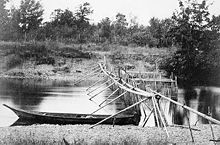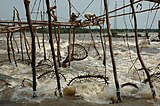
The Menai Strait is a strait which separates the island of Anglesey from Gwynedd, on the mainland of Wales. It is situated between Caernarfon Bay in the south-west and Conwy Bay in the north-east, which are both inlets of the Irish Sea. The strait is about 25 km (16 mi) long and varies in width from 400 metres (1,300 ft) between Fort Belan and Abermenai Point to 7.5 kilometres (4.7 mi) between Puffin Island and Penmaenmawr. It contains several islands, including Church Island, on which is located St Tysilio's Church.
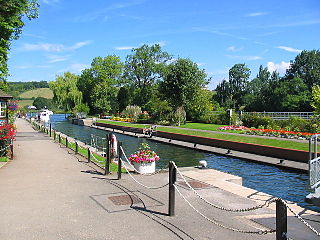
The English River Thames is navigable from Cricklade or Lechlade to the sea, and this part of the river falls 71 meters (234 feet). There are 45 locks on the river, each with one or more adjacent weirs. These lock and weir combinations are used for controlling the flow of water down the river, most notably when there is a risk of flooding, and provide for navigation above the tideway.
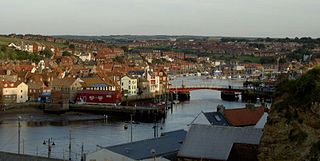
The River Esk is a river in North Yorkshire, England that empties into the North Sea at Whitby after a course of around 28 miles (45 km) through the valley of Eskdale, named after the river itself. The river's name is derived from the Brythonic word "isca" meaning "water". The Esk is the only major river in Yorkshire that flows directly into the North Sea; all other watercourses defined as being major rivers by the Environment Agency, either flow to the North Sea via the River Tees or the Humber Estuary.

Ynys Gored Goch, sometimes Ynys Gorad Goch, is a small island in the Menai Strait between Gwynedd and Anglesey in north Wales. It is situated in the stretch of the strait called the Swellies between Thomas Telford's Menai Suspension Bridge and Robert Stephenson's Britannia Bridge.
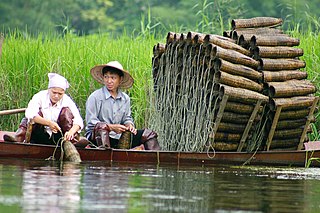
A fish trap is a trap used for catching fish and other aquatic animals of value. Fish traps include fishing weirs, cage traps, fish wheels and some fishing net rigs such as fyke nets.
Dulas Bay is a small bay on the north east coast of Anglesey, north Wales, forming the boundary between Llaneilian and Moelfre communities. The bay is bordered by three beaches.

Fishing tackle is the equipment used by anglers when fishing. Almost any equipment or gear used in fishing can be called fishing tackle, examples being hooks, lines, baits/lures, rods, reels, floats, sinkers/feeders, nets, spears, gaffs and traps, as well as wires, snaps, beads, spoons, blades, spinners, clevises and tools that make it easy to tie knots.

St. Marys Bay south western Nova Scotia, Canada, is surrounded by the modern municipal districts of Clare Municipal District and Digby.

The food of the Tlingit people, an indigenous group of people from Alaska, British Columbia, and the Yukon, is a central part of Tlingit culture, and the land is an abundant provider. A saying amongst the Tlingit is that "When the tide goes out the table is set." This refers to the richness of intertidal life found on the beaches of Southeast Alaska, most of which can be harvested for food. Another saying is that "in Lingít Aaní you have to be an idiot to starve". Since food is so easy to gather from the beaches, a person who cannot feed himself at least enough to stay alive is considered a fool, perhaps mentally incompetent or suffering from very bad luck. Though eating off the beach could provide a fairly healthy and varied diet, eating nothing but "beach food" is considered contemptible among the Tlingit, and a sign of poverty. Shamans and their families were required to abstain from all food gathered from the beach, and men might avoid eating beach food before battles or strenuous activities in the belief that it would weaken them spiritually and perhaps physically as well. Thus for both spiritual reasons as well as to add some variety to the diet, the Tlingit harvest many other resources for food besides what they easily find outside their front doors. No other food resource receives as much emphasis as salmon; however, seal and game are both close seconds.

Fishing techniques are methods for catching fish. The term may also be applied to methods for catching other aquatic animals such as molluscs and edible marine invertebrates.
A fishing basket is a basket used as a trap for fishing.

In archeological literature, the name Boylston Street Fishweir refers to ancient fishing structures first discovered in 1913, buried 29 to 40 feet below Boylston Street in Boston, Massachusetts. Reports written in 1942 and 1949 describe what was thought to be remains of one large fishweir, 2,500 years old, made of up to 65,000 wooden stakes distributed over an estimated 2 hectares of the former mud flat and marshland in what is now the Back Bay section of Boston. A different interpretation of these findings is offered by new evidence and contemporary archeological research techniques.

The Salmon and Freshwater Fisheries Act 1975 is a law passed by the government of the United Kingdom in an attempt to protect salmon and trout from commercial poaching, to protect migration routes, to prevent willful vandalism and neglect of fisheries, ensure correct licensing and water authority approval. This helps to sustain the rural inland freshwater fisheries industry, which employs around 37,000 people in the UK.
The Sebasticook Lake Fishweir Complex is a series of prehistoric fishing weir structures submerged in the waters of Sebasticook Lake in Newport, Maine. With radiocarbon dates as far back as 3000 BCE, it is one of the oldest structures of its type in North America, and the only one in eastern North America that has been directly dated. Its existence provides evidence of large-scale organization among Native Americans of the period in northeastern North America necessary to create structures of its complexity. The complex was listed on the National Register of Historic Places in 1994.

The Stilbaai Tidal Fish Traps are ancient intertidal stonewall fish traps that occur in various spots on the Western Cape coast of South Africa from Gansbaai to Mosselbaai.
The Coast Salish people of the Canadian Pacific coast depend on salmon as a staple food source, as they have done for thousands of years. Salmon has also served as a source of wealth and trade and is deeply embedded in their culture, identity, and existence as First Nations people of Canada. Traditional fishing is deeply tied to Coast Salish culture and salmon were seen "as gift-bearing relatives, and were treated with great respect" since all living things were once people according to traditional Coast Salish beliefs. Salmon are seen by the Coast Salish peoples are beings similar to people but spiritually superior.

The Menai Strait fish weirs are historically important fishing traps used in the fast-flowing tidal waters of the Menai Strait, which separates Anglesey from the rest of North Wales. The strait was particularly well suited to utilising fish weirs. The tidal waters pull huge volumes of water past the coastline with every tide, and the weirs and traps enabled fish to be concentrated into small holding areas from which they can be readily caught. Such methods are thought to have been used from earliest times, but the submerged and standing remains along both the Anglesey and Gwynedd coasts are from medieval and post-medieval periods, and in some cases were still in use into the 20th century.

Llanddona fish weir is a post-medieval fish trap sited in Llanddona, on the Isle of Anglesey. The fish weir is a scheduled monument.

Brewarrina Aboriginal Fish Traps are heritage-listed Australian Aboriginal fish traps on the Barwon River at Brewarrina, Brewarrina Shire, New South Wales, Australia. They are also known as Baiame's Ngunnhu, Nonah, or Nyemba Fish Traps. The Brewarrina Aboriginal Cultural Museum, opened in 1988, adjoins the site. The fish traps were added to the New South Wales State Heritage Register on 11 August 2000 and to the Australian National Heritage List on 3 June 2005.

Haaf net fishing is an ancient type of salmon and sea trout net fishing practised in Britain, and is particularly associated with the Solway Firth, the estuary forming part of the border between England and Scotland. The technique involves fishermen standing chest-deep in the sea and using large submerged framed nets to scoop up fish that swim towards them. It is a form of fishing that is believed to have been brought to Britain by the Vikings more than a thousand years ago and to have been practised in the Solway Firth since then.



